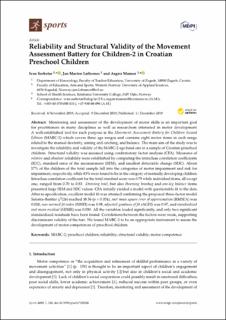| dc.description.abstract | Monitoring and assessment of the development of motor skills is an important goal for practitioners in many disciplines as well as researchers interested in motor development. A well-established tool for such purpose is the Movement Assessment Battery for Children Second Edition (MABC-2) which covers three age ranges and contains eight motor items in each range related to the manual dexterity, aiming and catching, and balance. The main aim of the study was to investigate the reliability and validity of the MABC-2 age band one in a sample of Croatian preschool children. Structural validity was assessed using confirmatory factor analysis (CFA). Measures of relative and absolute reliability were established by computing the intraclass correlation coefficients (ICC), standard error of the measurement (SEM), and smallest detectable change (SDC). About 17% of the children of the total sample fall into the categories of motor impairment and risk for impairment, respectively, while 83% were found to be in the category of normally developing children. Intraclass correlation coefficient for the total standard score was 0.79 while individual items, all except one, ranged from 0.70 to 0.83. Drawing trail, but also throwing beanbag and one-leg balance items presented large SEM and SDC values. CFA initially yielded a model with questionable fit to the data. After re-specification, excellent model fit was attained confirming the proposed three-factor model. Satorra–Bentler χ2(26) reached 38.56 (p = 0.054), root mean square error of approximation (RMSEA) was 0.028, non-normed fit index (NNFI) was 0.98, adjusted goodness of fit (AGFI) was 0.97, and standardized root mean residual (SRMR) was 0.030. All the variables loaded significantly, and only two significant standardized residuals have been found. Correlations between the factors were weak, supporting discriminant validity of the test. We found MABC-2 to be an appropriate instrument to assess the development of motor competences of preschool children. | en_US |

